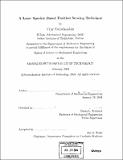A laser speckle based position sensing technique
Author(s)
Shilpiekandula, Vijay, 1979-
DownloadFull printable version (12.77Mb)
Other Contributors
Massachusetts Institute of Technology. Dept. of Mechanical Engineering.
Advisor
David L. Trumper.
Terms of use
Metadata
Show full item recordAbstract
This thesis presents the design and development of a novel laser-speckle-based position sensing technique. In our prototype implementation, a He-Ne laser beam is directed at the surface of an air-bearing spindle. An imaging system is set up to capture speckle patterns scattered from the spindle surface. These patterns are highly correlated over small angular displacements of the spindle. We use correlation-based image-processing algorithms to measure offsets between the speckle patterns. These offsets are calibrated against the counts of a commercial incremental optical encoder. A custom-built bicell photointerrupter unit is used as a reference sensor for the incremental optical encoder. To test for the control performance of this speckle-based sensor, we have constructed a transmission drive to run the air-bearing spindle. Our speckle-based metrology system is able to run at update rates of 10 Hz with a measured closed loop -3 dB bandwidth of about 2 Hz. Using a real-time processor interfaced with a desktop PC, we have implemented a novel algorithm that interpolates position estimates with respect to two pre-stored global images. We predict that this technique can potentially achieve resolutions of 0.1 [mu]m for translational and 5 [mu]rad for rotational motion. The limitation of our current implementation is the low update rates resulting from the time-intensive nature of correlation-based methods. Possible methods to overcome this limitation are addressed and ideas for follow-on work are presented.
Description
Thesis (S.M.)--Massachusetts Institute of Technology, Dept. of Mechanical Engineering, 2004. Includes bibliographical references (p. 129-131).
Date issued
2004Department
Massachusetts Institute of Technology. Department of Mechanical EngineeringPublisher
Massachusetts Institute of Technology
Keywords
Mechanical Engineering.